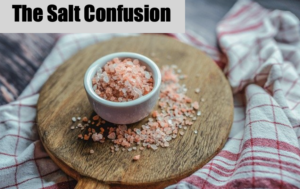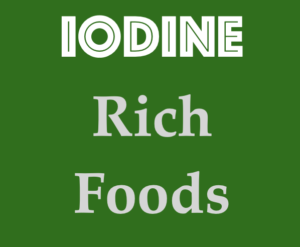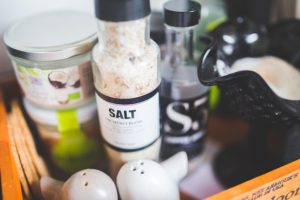 Have you stood in the salt aisle at the store and felt dazed and confused?
Have you stood in the salt aisle at the store and felt dazed and confused?
There was a time when there were two options: iodized table salt or sea salt.
Now, there is an array of salts including table salt, iodized salt, kosher salt, sea salt, Himalayan pink salt, Fleur de sel, celtic sea salt and many others. It’s enough to make your head spin!
As you know, our motto at Eat REAL America is:
keep it simple and eat REAL.
Which is why our recent coaching tip tried to help clear up the confusion about what type of rice to eat. This week, we want to help you “keep it simple” when it comes to salt.
So, here’s what you need to know…
The main differences in salt relate to processing, texture, flavor and iodine content.
Why is iodine important?
For those who may not be familiar with iodine, our bodies require iodine for proper development and growth. Iodine deficiencies can lead to enlarged thyroids (since much of our iodine is stored in our thyroids), fatigue, slower metabolism, weight gain and other neurological, gastrointestinal and skin issues.
You can get iodine naturally by eating saltwater seafoods and vegetables grown in iodine-rich soils. Keep in mind, the amount of iodine in fruits and vegetables depends a lot on the soil, fertilizer, and irrigation practices used to grow the crops. Some iodine-rich foods include:
 Dried seaweed
Dried seaweed- Seafood such as cod, snapper, salmon, canned tuna, and shrimp
- Eggs (specifically egg yolks from cage free eggs)
- Dairy
- Dark chocolate (because cocao contains iodine)
- Vegetables with the highest amounts of iodine include potatoes, lima beans, green beans and watercress. Other beans, such as kidney beans and navy beans, are also a good source for iodine (for example, Eden canned beans (BPA-free) are made with kombu seaweed which increases trace nutrients like iodine and helps with digestion).
- Fruits such as bananas, strawberries, pineapple, cranberries, dried prunes and rhubarb.
- In addition to these natural sources, you can also get iodine from salts that have been fortified with iodine.
Too much…
 With the Standard American Diet (SAD), Americans are consuming a lot of salt from processed and fast foods, but these salts are typically not iodized. The result can be an unhealthy combination of too much sodium and not enough iodine.
With the Standard American Diet (SAD), Americans are consuming a lot of salt from processed and fast foods, but these salts are typically not iodized. The result can be an unhealthy combination of too much sodium and not enough iodine.
If you follow our motto of EAT REAL FOOD, you are likely at the other end of the spectrum…you are naturally keeping both your sodium and iodine intake at optimal levels. Congratulations!
This is another example of why it is so important to eat REAL food and let the nutrients take care of themselves.
What about the different types of salts?
 Table salt: mined from underground salt deposits, and then superheated. The heating and bleaching of this salt removes many of the beneficial compounds. Table salt is often fortified with iodine (this will be indicated on the label). There are often other additives used to slow moisture absorption, prevent caking and make it “free-flowing.”
Table salt: mined from underground salt deposits, and then superheated. The heating and bleaching of this salt removes many of the beneficial compounds. Table salt is often fortified with iodine (this will be indicated on the label). There are often other additives used to slow moisture absorption, prevent caking and make it “free-flowing.”- Kosher salt: can come from underground mines or from the sea, and tends to be less processed and contains fewer additives. It typically does not contain iodine. Its grains are course and flat, making it a good salt to use for curing meats.
- Sea salt: comes from the ocean or saltwater lakes. There are various types of sea salt, typically related to where they are harvested from. It is less processed than table salt and an evaporation process is used to separate the salt from the water. Sea salt contains a small amount of iodine, but not nearly as much as iodized salt. Some think the minerals in sea salt add flavor and color compared to table salt.
- Himalayan pink salt: a sea salt that is harvested from the seabeds in the Himalayan mountains. The pink color results from its rich iron content. Some think it has a saltier taste, meaning you can obtain the same flavor with less salt content.
- Celtic sea salt (or gray salt): another sea salt and is harvested from France. Its color comes from the clay where it is harvested. It also has a good mineral content and tends to be a little more expensive than other sea salts.
- Fleur de sel: more expensive option you may find at the store. It is hand-harvested along the French coastline and many think it has a more delicate flavor and texture. Because of its price, it is often used as a “finishing salt,” especially in some restaurants.
Which salt is the best nutritionally?
Here’s the deal. All salts are primarily sodium chloride (remember, NaCl from chemistry class?). For the varieties that are less processed (like kosher and sea salts), there is a higher mineral content. These minerals may provide noticeable differences in flavor and color; however, because the mineral content is so small overall, the differences aren’t likely to provide significant health benefits.
In order to get health benefits from these minerals, you would have to consume a high quantity of salt which then creates adverse health effects like excessive sodium — not a good trade-off! Instead of relying on salt for beneficial minerals, you should focus on getting those and other nutrients from the rest of your diet by eating a wide variety of REAL food, especially fruits and vegetables.
Here’s the REAL deal:
- Try to increase your intake of natural iodine sources or choose iodized salt. If you are unable to eat seafood twice weekly, and at least 3 vegetables daily, then you do risk running low on on iodine, and therefore may benefit from iodized salt.
- If your diet does NOT lack iodine, use the salt you enjoy the most. Experiment with different textures and varieties to find your favorites.
- Use salts without additives whenever possible. Look for one ingredient: salt.
- Always use salt in moderation. Our bodies need the sodium that salt provides, but too much sodium can have negative health effects. Read our coaching tip on the effects of too much sodium and don’t forget that increasing your potassium intake can be just as important!
Salt provides wonderful flavor for our meals. It is also good for us…up to a point. Don’t be intimidated by all of the options. Eat a wide variety of REAL food, and there’s no reason to obsess — simply enjoy the salt you like best!
 LEARN MORE ABOUT THE NAPKIN!
LEARN MORE ABOUT THE NAPKIN!



Leave A Comment